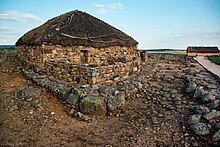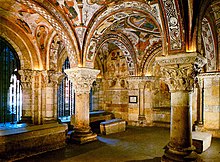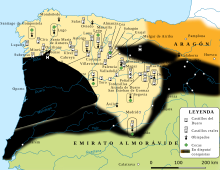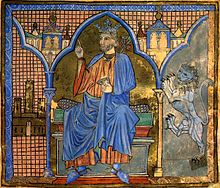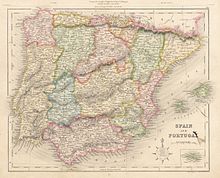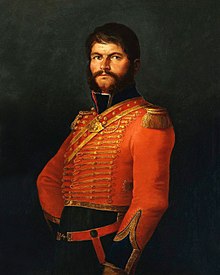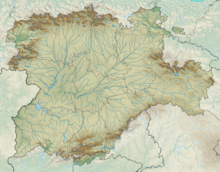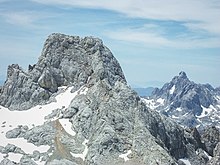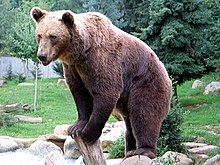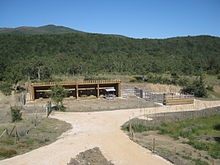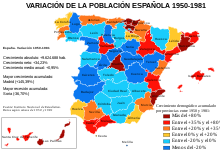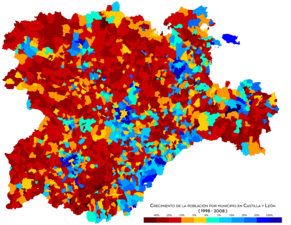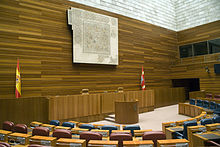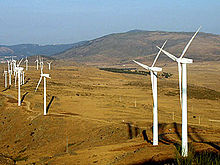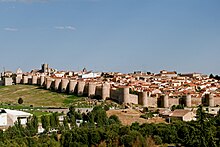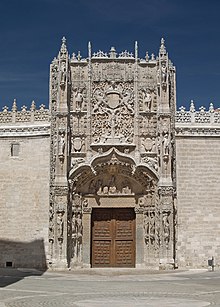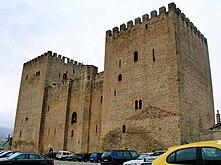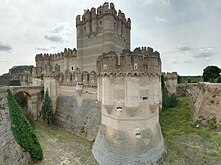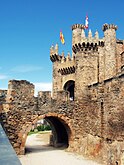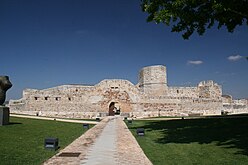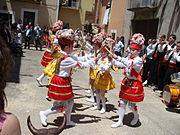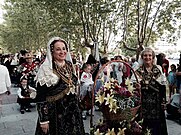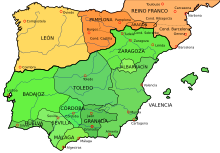Castile and Leon
Castilla y León is a Spanish autonomous community, referred to as a "historical and cultural community" in its Statute of Autonomy. It was established as a pre-autonomy in 1978 and acquired its status as an autonomous community in 1983. Its territory is located in the northern part of the plateau of the Iberian Peninsula and corresponds mainly to the Spanish part of the Duero river basin. It is made up of nine provinces: Ávila, Burgos, León, Palencia, Salamanca, Segovia, Soria, Valladolid and Zamora. It is the largest region in Spain and one of the largest in Europe, with an area of &&&&&&&&&&094226.&&&&&094,226 km²; it is also the sixth most populous nation, with &&&&&&&&02383139.&&&&&02,383,139 inhabitants in 2021.
Since the beginning of the federalist debate in Spain in the XIX century during the First Republic there were autonomy projects for a Castilian and Leonese region, although also including the current Cantabria and La Rioja. The same project continued to exist during the Second Republic and was finally carried out after the 1978 Constitution, but without Cantabria and La Rioja which, although it was considered to include them, they finally formed uniprovincial autonomies.
Its Statute of Autonomy declares in its preamble:
The Autonomous Community of Castile and Leon emerges from the modern union of the historical territories that composed and gave name to the old crowns of León and of Castile. A thousand hundred years ago the Kingdom of Lion was established, from which they were degated as kingdoms throughout the century xi and, in 1143, Portugal. During these two centuries, the monarchs who bore the rule of these lands attained the dignity of emperors, as the intituations of Alfonso VI and Alfonso VII testify.
The Statute of Autonomy defines a series of essential values and symbols of the inhabitants of Castilla y León, such as their linguistic heritage —alluding to the Spanish language and the rest of the languages spoken in the community: Leonese and Galician— or its historical, artistic and natural heritage. Among the symbols are the coat of arms, the flag, the banner, the anthem —despite the fact that it does not exist—, while April 23 is defined as Castilla y León Day, in commemoration of the defeat suffered by the communal armies of the Castilian Communities of Villa and Tierra in Villalar during the War of the Communities, in 1521.
The heritage of Castilla y León includes: 9 World Heritage Sites, almost 1,800 classified cultural interest assets, 112 historical complexes, 400 museums, more than 500 castles, of which 16 are considered of high historical value, 12 cathedrals, 1 co-cathedral, and the largest concentration of Romanesque art in the world. Castilla y León, together with the Italian region of Lombardy, constitutes the region in the world with the most properties distinguished with the highest figure of protection granted by Unesco, with a total of 11 properties.
Likewise, the mountains of Valsaín and the mountain ranges of Béjar and Francia, in the Central system, the valleys of Laciana, Omaña and Luna and the Picos de Europa and Los Ancares, in the Cantabrian mountain range, and the Iberian Plateau, in the border area with Portugal, have been declared a biosphere reserve by Unesco, which also recognizes the Las Loras geopark, to the north of the community. In addition, Castilla y León is strongly related to three of the UNESCO Memory of the World Program records, such as the Decree of the Cortes de León of 1188, a royal curia considered the cradle of world parliamentarianism by the city itself. institution, the General Archive of Simancas of the Crown of Castile and the Treaty of Tordesillas.
On the other hand, in Castilla y León it is found around 50% of all the patrimony owned by the Catholic Church in Spain.
Its per capita GDP places Castilla y León in eighth place in Spain (INE 2016). Its human development index (0.909) is the seventh highest in the country, and is ahead of countries like France or Italy. The Index of development of social services reflects that the community has one of the best social services in the country, ranking as the third autonomous region that offers the best benefits to its citizens, behind the Basque Country and Navarra Its education, according to the 2015 PISA Report, tops the scores in reading and science with a rating comparable to that of the ten best countries in the study.
Symbols
The Statute of Autonomy of Castilla y León, reformed for the last time in 2007, establishes in the sixth article of its preliminary title the symbols of exclusive identity of the community. These are: the coat of arms, the flag, the banner and the anthem. Its legal protection is the same that corresponds to the symbols of the State —whose outrages are classified as a crime in article 543 of the Penal Code.
In the statutory articles, the shield is defined as follows:
Castile and Leon's blazon is a shield dyed by an open royal crown, barracks on the cross or counterpart. The first and fourth barracks: in the field of Gules, a three-warm gold castle, sable mamposted and juiced. The second and third barracks: in silver field, a rampant lion of purple, flaxed, nailed and armed with gules, crowned with gold.
Also, the flag is described as follows:
The flag of Castile and Leon is barracks and contains the symbols of Castile and Leon, as described in the previous section. The flag will wave in all the official centers and acts of the Community, on the right of the Spanish flag.
Abiding by the same wording, the banner is made up of the quartered shield on a traditional crimson background. The Statute also states: "The hymn and other symbols [...] will be regulated by specific law." After the promulgation of the fundamental norm, said law was not promulgated, so the anthem does not exist, but de iure is a symbol of autonomy.
History
The autonomous community of Castilla y León is the result of the union in 1983 of nine provinces: the three that, after the territorial division of 1833, by which the current provinces were created, were attached to the Region of León (Salamanca, Zamora and León) and six attached to Castilla la Vieja (Burgos, Soria, Segovia, Ávila, Valladolid and Palencia), except in the latter case the provinces of Santander (current community of Cantabria) and Logroño (current La Rioja).
In the case of Cantabria, the creation of an autonomous community was defended for historical, cultural and geographical reasons, while in La Rioja the process was more complex due to the existence of three paths, all of them based on both historical and cultural reasons. socio-economic: union with Castilla y León (Union of the Democratic Center), union with a Basque-Navarra community (Socialist Party and Communist Party)[citation required] or creation of a uniprovincial autonomy, option taken before the majority support of its population.
There are several archaeological findings that show that in prehistoric times these lands were already inhabited. In the Sierra de Atapuerca, a large number of bones of the ancestors of Homo sapiens have been found, making these findings one of the most important for determining the history of human evolution. The most important discovery that catapulted the site to international fame was that of the remains of Homo heidelbergensis.
During the Neolithic, it is known that the northern sub-plateau was inhabited and diverse material culture of the time has been found. This material culture is known by the name of Las Cogotas.
Before the arrival of the Romans, it is known that the territories that make up Castilla y León today were occupied by various Celtic peoples, such as the Vacceos, the Autrigones, the Turmogos, the Vetones, the Astures or the Celtiberians.
With the arrival of the Roman troops, there were clashes between the pre-Roman peoples and these. In history remains the resistance of Numancia, near the current Soria.
Romanization was unstoppable, and great Roman works of art have remained to this day, mainly the Aqueduct of Segovia as well as many archaeological remains such as those of ancient Clunia, the Salinas de Poza de la Sal and the Vía de la Plata, originating in Astorga (Asturica Augusta) and crossing the west of the community to the capital of Extremadura, Mérida (Augusta Emerita).
With the fall of Rome, the lands were occupied militarily by the Visigothic peoples. The subsequent arrival of the Muslims and the subsequent reconquest have a lot to do with the current ethnic composition of the Iberian Peninsula. In the mountainous area of present-day Asturias, a small Christian kingdom was formed that opposed the Islamic presence in the Peninsula. They proclaimed themselves heirs of the last Visigothic kings, who in turn had been deeply Romanized. This resistance, of Visigothic-Roman heritage and supported by Christianity, grew stronger and expanded to the south, moving its capital to the city of León and thus creating the Kingdom of León. To favor the repopulation of the new reconquered lands, privileges or repopulation letters were granted by the monarchs. The foramontanos would be those people who settled in the northern sub-plateau from the mountains of Asturias and Cantabria. The first charter that is known and that confirms this process is the charter of Brañosera.
In the Middle Ages, Christianity made pilgrimages to Santiago de Compostela popular. The Camino de Santiago runs throughout the region, which contributed to the European culture traveling and expanding through the peninsula. Today said Camino continues to be a tourist and cultural claim of the first order.
In 1188 the Basilica of San Isidoro de León had been the seat of the first Courts in the history of Europe with the participation of the Third Estate. The king who summoned them was Alfonso IX.
The legal basis was Roman law, due to which the kings increasingly wanted more power, similar to the Roman emperors. This fact is seen very clearly in the Siete Partidas of Alfonso X the Wise, which makes clear the imperial monism that he sought. The king did not want to be a primus inter pares, the king was the source of law.
Simultaneously, a county of this Christian kingdom of León began to acquire autonomy and expand. It is the original County of Castilla, which will grow to become a true kingdom of great strength among the Christian kingdoms of the peninsula. The first Castilian count was Fernán González.
León and Castilla continued to expand to the south, even beyond the Duero with their aim of fighting and reconquering against Islam. We are in the Middle Ages and the epic songs narrate the great deeds of the Christian nobles who fought against the Muslim enemy. Despite this, the Christian and Muslim kings maintained diplomatic relations. A clear example is Rodrigo Díaz de Vivar, El Cid, the paradigm of the medieval Christian knight, who fought alongside both Christian and Muslim kings.
The bases for the dynastic unification of the kingdoms of Castilla y León, separated by only seven decades, had been laid in 1194. Alfonso VIII of Castile and Alfonso IX of León signed the treaty in Tordehumos by which the area was pacified of Tierra de Campos and laid the foundations for a future reunification of the kingdoms,[citation required] consolidated in 1230 with Fernando III the Saint. This agreement has gone down in history as the Treaty of Tordehumos. With Ferdinand III, Castilla y León was definitively united under the same king and up to the present day, and before him the kingdoms had already remained under the same command for some seasons. The Cortes of Castilla and León were unified after a period in which they had remained separate, thus confirming territorial unity.
During the Late Middle Ages there was an economic and political crisis caused by a series of bad harvests and by disputes between nobles and the Crown for power, as well as between different contenders for the throne. In the Courts of Valladolid in 1295, Fernando IV is recognized as king. The work María de Molina presents her son Fernando IV in the Cortes of Valladolid in 1295, today presiding over the Congress of Deputies together with a picture of the Cortes of Cádiz, emphasizing the parliamentary importance of the entire development of Cortes in Castilla y León despite its subsequent decline. The Crown became more authoritarian and the nobility more dependent on it.
The reconquest continued to advance in this thriving Crown of Castile, culminating in the surrender of the Nasrid Kingdom of Granada, the last Muslim stronghold on the Peninsula. At this time, the kings had already acquired great power, thus establishing the era of authoritarian monarchies.
The Catholic Monarchs divided up the maritime routes and the New World with the Portuguese crown in the Treaty of Tordesillas.
Already in the Modern Age with the arrival of a new dynasty, the Habsburgs, Castile fell into a civil war, the Communities of Castile. The Austro-Burgundian monarchs brought an imperial vision that in view of the Castilians did not benefit this land. The new monarchs, moreover, yearned not for an authoritarian monarchy, but for an absolute one, and the medieval Courts represented by the three estates only hindered those ambitions. Finally the commoners were defeated and the Habsburgs strengthened their power.
The northern sub-plateau had a peak economic moment at the beginning of the Modern Age, with Valladolid as the capital of the kingdom and wool production going to Flanders.
However, after Madrid became the capital and due to the indebtedness of the kingdom in various European wars, the XVII centuries and XVIII were decadent for the territory. Said process began to mitigate slightly with the first Societies of Friends of the Country, the first industrialization around flour factories and enlightened projects such as the Canal de Castilla.
However, this process was relegated by the Spanish War of Independence against Napoleon's France. The battle of Arapiles was an important moment of this war, as well as there were important guerrilla leaders such as El Empecinado.
The 19th century marked the formation of Spain as a constitutional nation. Evaristo Pérez de Castro was president of the Council of Ministers of Spain during the reign of Isabel II. A second industrialization takes place around the railway and mining in the northern areas of León and Palencia (see Palencia mining basin). In 1836 the Council of the Mesta was suppressed. In general terms, we find ourselves with an eminently agricultural and rural region, where most of the most important population centers are in decline and industrialization has largely passed by.
Manuel Ruiz Zorrilla was president of the Council of Ministers and played an important role in Spanish politics during the Democratic Six-year period. It is at this time that the first attempts at decentralization took place in Spain, also emerging regionalist and federalist tendencies that resulted in the Castilian Federal Pact promoted by the Federal Republican Party and the Castilian Commonwealth project already in times of the Bourbon Restoration.
Already in the XX century we found a trend of rural abandonment that had started at the end of the XIX towards Madrid and the industrial poles of Spain, such as the Basque Country or Catalonia. The depopulation process has had lasting effects on the community, with consequences that continue to this day.
This trend was slightly mitigated around the Burgos-Palencia-Valladolid industrial pole and thanks to the automobile industry, which allowed Valladolid to gain population unlike the rest of the community during the second half of the century XX.
The economic crisis of the early XXI century and the aging of the population, as well as the scant industrial weight in the community and the process of metropolization of Spain in Madrid, continues to cause the loss of generalized population of the community. However, human development indices are above the Spanish average.
Background to autonomy
In June 1978, Castilla y León obtained the pre-autonomous regime, through the creation of the General Council by Royal Decree-Law 20/1978, of June 13.
During the First Republic (1873-1874), the federal republicans conceived the project of creating a single federated state of eleven provinces in the Spanish Duero Valley, which would also have included the provinces of Santander and Logroño. Very a few years earlier, in 1869, as part of a manifesto, federal republicans representing the 17 provinces of Albacete, Ávila, Burgos, Ciudad Real, Cuenca, Guadalajara, León, Logroño, Madrid, Palencia, Salamanca, Santander, Segovia, Soria, Toledo, Valladolid and Zamora proposed in the so-called Castilian Federal Pact the formation of an entity made up of two different "states": the state of Castilla la Vieja - which would have been made up of the current Castilian and Leonese provinces together with those of Logroño and Santander —, and the state of Castilla la Nueva —which would have been made up of the current provinces of Castilla-La Mancha plus the province of Madrid. The end of the Republic, at the beginning of 1874, gave the tr take the initiative.
In 1921, on the occasion of the fourth centenary of the Battle of Villalar, the Santander City Council advocated the creation of a Castilian and Leonese commonwealth of eleven provinces, an idea that would be maintained in later years. At the end of 1931 and the beginning of 1932, from León, Eugenio Merino elaborated a text in which he laid the foundations of a Castilian-Leon regionalism. The text was published in the Diario de León.
During the Second Republic, especially in 1936, there was great regionalist activity in favor of a region of eleven provinces, and even some bases for a Statute of Autonomy were drawn up. The Diario de León advocated for the formalization of this initiative and the constitution of an autonomous region with these words:
Join in a personality to Leon and Castilla la Vieja around the great basin of the Duero, without now falling into pueblerina rivalries.Diario de LeónMay 22, 1936.
The end of the Civil War and the beginning of the Franco regime put an end to the aspirations of autonomy for the region. The philosopher José Ortega y Gasset collected this scheme in his publications.
After the death of Francisco Franco, regionalist, autonomist and nationalist organizations arose (Castilian-Leon regionalism and Castilian nationalism) such as the Regional Alliance of Castilla y León (1975), the Regional Institute of Castilla y León (1976) or the Partido Autonómico Nacionalista de Castile and Leon (1977). Later, after the extinction of these formations, the Regionalist Unit of Castilla y León emerged in 1993.
At the same time, others of a Leonese nature arose, such as the Leonese Autonomous Group (1978) or the Partido Regionalista del País Leonés (1980), which advocated the creation of an autonomous community of Leon, made up of the provinces of León, Salamanca and Zamora. The popular and political support that maintained uniprovincial autonomy in León became very important in that city.[citation required]
After the Castilian-Leon pre-autonomous body came into operation, to whose creation the León Provincial Council contributed in its agreement of April 16, 1980, the same Leon institution revoked its original agreement on January 13, 1983, just when the draft Organic Law entered the Spanish parliament. The existence of contradictory agreements and which was valid was resolved by the Constitutional Court in Judgment 89/1984, of September 28, in its legal basis it declares that the subject of the process is no longer integrated, as in its drive phase preliminary, by the councils and municipalities, but it is a new body that was born because the driving will has already been manifested and that now expresses that of the territory as a whole; and that will already has a different object, the future legal regime of the territory that has already expressed its will to become an autonomous community through acts of initiative that have already exhausted their effects.
Coinciding with that ruling, different demonstrations took place in León, some numerous, in favor of the León alone option, which according to some sources brought together a number close to &&&&&&&&&&090000.&&&&&090,000 attendees, this being the largest concentration held in the city in Democracy until the subsequent rejection of the attacks of March 11, 2004.
In an agreement adopted on July 31, 1981, the Provincial Council of Segovia decided to exercise the initiative so that Segovia could become a uniprovincial autonomous community, but in the municipalities of the province the situation was equal among the supporters of uniprovincial autonomy or with the rest of Castilla y León.
The Cuéllar city council initially adhered to this autonomous initiative in an agreement adopted by the corporation on October 5, 1981. However, another agreement adopted by the same corporation on December 3 of the same year revoked the previous one and the The process was paralyzed pending the processing of an appeal filed by the provincial council against this last agreement. This change of opinion of the Cuéllar city council tilted the balance in the province towards autonomy with the rest of Castilla y León, but it was an agreement it arrived out of time. Finally, the province of Segovia was incorporated into Castilla y León together with the other eight provinces and legal coverage was given by Organic Law 5/1983, for "reasons of national interest", as provided for in article 144 c) of the Spanish Constitution for those provinces that have not exercised their right on time.
Today, the Villalar Foundation is in charge of carrying out cultural activities on the art, culture or hallmarks of Castilla y León.
Every year, on the occasion of Castilla y León Day, the community awards the Castilla y León Awards to outstanding Castilian-Leonese people in the following areas: arts, human values, scientific research, social sciences, restoration and conservation, environment and sports.
Geography
Castilla y León is a landlocked autonomous community located in the northwestern quadrant of the Iberian Peninsula. Its territory limits to the north with the uniprovincial communities of the Principality of Asturias and Cantabria as well as with the Basque Country (Vizcaya and Álava); to the east with the uniprovincial community of La Rioja and with Aragón (province of Zaragoza), to the south with the Community of Madrid, Castilla-La Mancha (provinces of Toledo and Guadalajara) and Extremadura (province of Cáceres) and to the west with Galicia (provinces of Lugo and Orense) and Portugal.
Map of Castilla y León
Orography
The morphology of Castilla y León is formed, for the most part, by the Meseta and a belt of mountainous reliefs. The Plateau is a plateau, which has an average altitude close to 800 m above sea level, is covered by deposited clay materials that have given rise to a dry and arid landscape.
Following the morphology of the area, it can be seen: to the north, the mountains of the provinces of Palencia and León with high and spiky peaks and the mountains of the province of Burgos, divided into two parts by the Pancorbo gorge, link between the Basque Country and Castile. Of these, the northern part belongs to the Cantabrian mountain range and reaches the city of Burgos. The east-southeast zone, belonging to the Iberian system. In the northwest part the mountains of Zamora extend, with peaks plateaued by erosion. To the east, in the Soria mountains, you can see the Iberian system, presided over by Moncayo, its highest peak. Separating the northern Meseta from the southern one, to the south, rises the Central system, where the Gata, Francia, Béjar and Gredos mountain ranges are located in the western half and those of Ávila, Guadarrama, Somosierra and Ayllón in the eastern half.
Geology
The northern plateau is made up of Paleozoic bases. At the beginning of the Mesozoic, once the Hercynian folding that raised the current Central Europe and the Galician area of Spain had finished, the deposited materials were dragged by the erosive action of the rivers.
During the alpine folding, the materials that formed the plateau broke at multiple points. From this fracture the mountains of León rose, with mountains of not much height and, constituting the backbone of the Meseta, the Cantabrian mountain range and the Central system, formed of materials such as granite or metamorphic slates.
The karstic complex of Ojo Guareña, made up of 110 km of galleries and its caves formed in carbonate materials from the Coniacian that are located on a level of impermeable marl, is the second largest on the peninsula.
This geological configuration has allowed mineral-medicinal and/or thermal water outcrops, used now or in the past, in Almeida de Sayago, Boñar, Calabor, Caldas de Luna, Castromonte, Cucho, Gejuelo del Barro, Morales de Campos, Trescasas, Valdelateja and Villarijo, among other places.
Hydrography
Rivers
- Watershed of the Duero
The main hydrographic network of Castilla y León is made up of the Duero River and its tributaries.
From its source in the Picos de Urbión, in Soria, to its mouth in the Portuguese city of Porto, the Duero flows through &&&&&&&&&&&&0897.&&&&&0897 km. From the north the Pisuerga river, the Valderaduey river and the Esla river descend, their largest tributaries and to the east, with less water in their flows, the Adaja river and the Duratón river stand out. After passing the city of Zamora, the Duero is boxed in between the canyons of the Arribes del Duero Natural Park, bordering Portugal. Important tributaries reach it from the left bank, such as the Tormes River, the Huebra River, the Águeda River, the Coa River and the Paiva River, all coming from the Central system. From the right the Sabor river, the Túa river and the Támega river reach it, born in the Galaico massif. After the area of Arribes, the Duero turns west into Portugal until it flows into the Atlantic Ocean.
- Other watersheds
Several rivers in the community discharge their waters into the Ebro basin, in Palencia, Burgos and Soria (Jalón river), the Miño-Sil in León and Zamora, the Tagus in Ávila and Salamanca (Tiétar river and Alberche, and Alagón river respectively) and the Cantabrian hydrographic basin in the provinces through which the Cantabrian mountain range extends.
| Rio | Capital | Destroying | Other localities where it passes |
|---|---|---|---|
| River Adaja | Avila | River Duero | Arévalo |
| River Arlanzón | Burgos | Arlanza River in Quintana del Puente | Arlanzón and Pampliega |
| River Bernesga | León | River Esla | The Robla. |
| River Carrión | Palencia | Pisuerga River in Dueñas | Guardo y Carrión de los Condes |
| River Tormes | Salamanca | River Duero in Fermoselle-Villarino | The Barco de Ávila, La Horcajada, Guijuelo, Alba de Tormes and Ledesma |
| River Youma | Segovia | River Adaja in Matapozuelos | Coca |
| River Duero | Soria and Zamora | Atlantic Ocean in Porto | Almazán, Aranda de Duero, Tordesillas, Toro, Aldeadávila de la Ribera and Vilvestre |
| Pisuerga River | Valladolid | River Duero in Geria | Aguilar de Campoo, Cervera de Pisuerga, Venta de Baños, Dueñas, Tariego de Cerrato y Simancas |
Lakes and reservoirs
In addition to the rivers, the Duero basin is also home to a large number of lakes and lagoons such as the Negra lagoon, in the Picos de Urbión, the Grande lagoon, in Gredos, the Sanabria lake, in Zamora, or the La Nava, in Palencia. They also highlight a large number of reservoirs, fed by water from the rains and the melting of the snowy peaks. Thus, Castilla y León, despite not having abundant rainfall, is one of the communities in Spain with the highest level of dammed water.
Many of these natural lakes are being used as an economic resource, boosting rural tourism and helping to preserve ecosystems. Lake Sanabria was a pioneer in this.[citation needed]
Climate
Castilla y León has a continental Mediterranean climate, with long, cold winters, average temperatures between 3 and 6 °C in January, and short, cold summers. hot (averages from 19 to 22 °C), but with the three or four months of summer aridity characteristic of the Mediterranean climate. Rainfall, with an average of 450-500 mm per year, is low, accentuating in the lower lands.
- Climate factors
In Castilla y León, the cold extends almost continuously during a large part of the year, being a very characteristic element of its climate. The coldest periods of winter are associated with invasions of a continental polar front and arctic sea air flows, rare is that with them temperatures of the order of -5 °C to -10°C. Likewise, in anticyclone situations, in the interior of the region they motivate persistent fog, creating prolonged cold situations due to radiation processes. The intense "cold waves" of the central winter months are typical, showing a particular tendency to occur from the second half of December to the first half of February. During its course, the most extreme minimum temperatures are produced, whose values vary between -10 °C and -13 °C in its westernmost sector and -15 °C and -20 °C of the central plains and high parameras. The lowest recorded records reach -22 °C in Burgos, -21.9 °C in Coca (Segovia), -20.4 °C in Ávila, -20 °C in Salamanca and -19.2 °C in Soria. The high altitude of the Meseta and its mountains accentuates the contrast between winter and summer temperatures, as well as those of day and night.
Due to the mountainous barriers that surround Castilla y León, the maritime winds are slowed down, thus stopping rainfall. Due to this, the rains fall in a very uneven way in the Castilian and Leonese territory. While in the center of the Duero basin there is an annual average of 450 mm, in the western regions of the León mountains, the Cantabrian mountain range and the In the southern zone of the provinces of Ávila and Salamanca, rainfall reaches 1500 mm per year, with a maximum of 3400 mm per year in the western part of the Sierra de Gredos, in the Candelario-Béjar massif, which makes this area the rainiest not only in Spain, but also in the Iberian Peninsula.
- Climate regions
Although Castilla y León is framed within the continental climate, different climatic domains are distinguished in its lands:
- According to the climate classification of Köppen, a large part of the autonomous community is framed in the Csb or Cfb variants, with the average of the warmest month below the 22 °C but above 10 °C for five or more months.
- In several areas of the central plateau, the climate is classified as Csa (warm mediterranean), to be exceeded 22 °C during the summer
- In elevated peaks of the Cantabrian mountain range and mountain areas, a cold temperate climate is given with lower average temperatures 3 °C in the coldest months and dry summers (Dsb or Dsc).
Ecology
The National Center for Environmental Education is based in Valsaín, province of Segovia. Its lines of work focus on the collection and dissemination of specialized information on environmental education; in the design and development of citizen awareness and participation programs; in the elaboration of educational materials and exhibitions; in the organization and support of seminars and other forums for reflection and debate; in the development and execution of environmental training actions; and in cooperation with other public and private entities for the promotion of environmental education.
Flora
Castilla y León has many protected natural spaces. It actively collaborates with the European Union Natura 2000 Network program, and 25% of the network's area is located in this region. There are also some special protection areas for birds or ZEPA. The solitary holm oaks (Quercus ilex) and junipers (Juniperus sect. Sabina) that now outline the Castilian-Leonese plain are remains of the forests that covered long ago time these same lands. The agricultural exploitations, due to the need for land for the cultivation of cereals and pastures for the immense herds of the Castilian mesta, meant the deforestation of these lands during the Middle Ages. The last Castilian and Leonese juniper forests are found in the provinces of León, Soria and Burgos. They are sparse forests that can form mixed communities with holm oaks, gall oaks (Quercus faginea) or pines (Pinus).
The Castilian and Leonese slopes of the Cantabrian mountains and the northern foothills of the Iberian system have rich vegetation. The wetter and cooler slopes are populated by large beech forests, whose extension areas can reach 1500 m above sea level. In turn, the beech (Fagus) forms mixed forests with the yew (Taxus baccata), the rowan (Sorbus), the whitebeam (Sorbus aria), holly (Ilex aquifolium) and birch (Betula). Sessile oak (Quercus petraea), charlo (Quercus robur), ash (Fraxinus), lime (Tilia), chestnut (Castanea sativa), birch and Lillo pine (Pinus sylvestris), a typical species of northern the province of Leon.
On the lower slopes of the Central system there are large areas of holm oaks. At a higher level, between 1000 and 1100 m s. no. m., chestnut groves abound. Above them, the Pyrenean (Quercus pyrenaica) predominates, very resistant to cold, whose layer extends up to the &&&&&&&&&&&01700.&&&&&01700 m s. no. m. However, many oak groves have disappeared, felled by man and replaced by reforestation pines. The main native pine forests are found in the Sierra de Guadarrama. The subalpine zones between 1700 and &&&&&&&&&&&02200.&&&&&02200 m s. no. m. host thickets of brooms and junipers (Juniperus).
A good part of the province of Salamanca, especially in the regions of Campo Charro and Ciudad Rodrigo, is occupied by meadows, a type of forest similar to that of African savannahs, with holm oaks, cork oaks (Quercus suber), gall oaks and cabbage (Quercus pyrenaica). The province of Salamanca and that of Valladolid in the Rueda region also have the only Castilian-Leonese olive groves, since these trees do not grow in any of the other regions of the community. It is also worth noting the wine regions with very good quality wines such as those from Toro, those from Ribera del Duero (Valladolid, Burgos, Soria), those from Rueda, or those from Cigales.
Wildlife
Castilla y León has a great diversity of fauna. There are numerous species and some of them are of special interest due to their uniqueness, such as some endemic species, or due to their scarcity, such as the brown bear. 418 species of vertebrates have been recorded, which constitute 63% of all the vertebrates that inhabit Spain. Animals adapted to life in the high mountains, inhabitants of crags, inhabitants of river courses, species of the plains and forest residents form the mosaic of the Castilian and Leonese fauna.
The isolation to which the high peaks are subjected favors the existence of abundant endemic species such as the ibex (Capra pyrenaica victoriae), which in Gredos constitutes a unique subspecies on the Peninsula. The snowy vole (Microtus nivalis) is a graceful, long-tailed, gray-brown micromammal that lives in open spaces above the tree line.
Small and large mammals such as squirrel, dormouse, mole, marten, marten, fox, wild cat, wolf, quite abundant in some areas, wild boar, deer, roe deer and, only in the Cantabrian mountain range, some brown bear specimens usually frequent deciduous forests, although some species also extend to coniferous forests and scrubland. In 2018, the bear population grew in Castilla y León, which has 13 bears and 21 cubs, distributed between the provinces of Palencia and León. The Bobcat (Felis silvestris) is slightly larger than a domestic cat, has a short, stout tail, dark rings, and striped fur. The Iberian lynx (Lynx pardina), however, lives almost exclusively in areas of Mediterranean scrub.
Small reptiles such as the ladder snake (Rhinechis scalaris), the southern smooth snake (Coronella girondica) and the Aesculapian snake (Zamenis longissimus). The European smooth snake (Coronella austriaca) can be found from sea level to 1800 m a.s.l. no. m. and in the community he tends to live in the heights. Still higher up, in the rocky areas of the subalpine floor at about 2400 m a.s.l. no. m. lives the mountain lizard (Lacerta monticola cyreni), one of the few reptiles adapted to these heights.
Mountain rivers are home to otters and excesses, and in their waters are trout, eels, minnows, and some of the increasingly rare native crayfish. The otter (Lutra lutra) and the desmanes (Galemys pyrenaica) are two mammals with aquatic habits and very good swimmers. The otter feeds mainly on fish, while the desman forages for its food among the aquatic invertebrates that inhabit the riverbed. In lower sections of calmer waters, barbels and carp swim. Among amphibians, newts and as notable species: the Almanzor salamander (Salamandra salamandra almanzoris) and the Gredos toad (Bufo bufo gredosicola), which are two endemic subspecies of the Central system.
Where the rivers are boxed in, forming gorges and canyons, rock-dwelling birds such as the griffon vulture, the black vulture, the Egyptian vulture, the golden eagle or the peregrine falcon live on the rocks. The Egyptian vulture (Neophron percnopterus), a small vulture, is black-and-white in color with a yellow head. Downstream and on its banks, among the exuberant vegetation, the herons and herons form their colonies, as well as the wren, the blowfly, the hoopoe and the kingfisher.
Among the birds that inhabit the open Mediterranean forests, there are two endangered species: the black stork (Ciconia nigra) and the Iberian imperial eagle (Aquila adalberti). The black stork, much rarer than its congener the white stork (Ciconia ciconia), is solitary and lives far from man. The Iberian imperial eagle nests in trees and feeds mainly on rabbits, but also on birds, reptiles and carrion.
In the coniferous forests live among others the treecreeper, the tick and the nuthatch (Sitta europaea), a bird with a gray back and reddish-orange flanks that nests in holes that narrow the entrance with mud. The capercaillie (Tetrao urogallus) is a very dark and large rooster that lives in forest environments, making it very difficult to observe. Among the forest birds of prey are the goshawk, the hawk or the tawny owl, which frequently attack other smaller birds such as jays, woodpeckers, finches, woodpeckers and warblers.
The great bustard (Otis tarda) frequents the open plains with dryland crops; It is large and has a greyish head and neck and a brown back. Numerous specimens of the Greylag Goose (Anser anser), which breeds in northern Europe and visits the area in winter, gather in the Castilian and Leonese wetlands during the winter.
The naturalist Félix Rodríguez de la Fuente (1928-1980), a native of the Burgos town of Poza de la Sal, is notable for scientific study and dissemination. He did extensive research work and rose to fame with the television series Man and the Earth (TVE).
In the Palencia Mountain, in the municipality of San Cebrián de Mudá, a reintroduction program of the European bison is being carried out, an animal that had not been present in the Iberian Peninsula for about 1000 years, in order to avoid extinction of the species.
Demographics
With &&&&&&&&02409164.&&& &&02,409,164 inhabitants (January 1, 2018), &&&&&&&&01186363.&&&&&01,186,363 males and &&&&&&&&01222801.&&&&&01,222,801 women span>, the population of Castilla y León represents 5.16% of the population of Spain, despite the fact that its vast territory covers almost a fifth of the total area of the country. In January 2018, the population of Castilla y León was distributed, by province, as follows: Ávila, &&&&&&&&&0158498.&&&&&0158,498 inhabitants; Burgos, &&&&&&&&&0357070.&&&&&0357 070; Leon, &&&&&&&&&0463746.&&&&&0463 746; Palencia, &&&&&&&&&0162035.&&&&&0162 035; Salamanca, &&&&&&&&&0331473.&&&&&0331 473; Segovia, &&&&&&&&&0153342.&&&&&0153 342; Soria, &&&&&&&&&&088600.&&&&&088 600; Valladolid, &&&&&&&&&0519851.&&&&&0519 851; and Zamora, &&&&&&&&&0174549.&&&&&0174,549.
The autonomous community has a very low demographic density, around 0Wrong expression: unknown punctuation character «,»..Wrong expression: unknown punctuation character «,».25.57 inhab./km², a record that is more than three times lower than the national average, which indicates that it is a sparsely populated region and demographically in decline, especially in rural areas and even in small traditional cities. The demographic characteristics of the territory show an aging population, with a low birth rate and a mortality that is close to the state average.
Life expectancy is higher than the Spanish average: 83.24 for women and 78.30 for men. A study by the University of Porto cites Castilla y León as one of the European regions with the longest-lived population.
Historical evolution of the population
Many of the people of the territory, who dedicated themselves mainly to agriculture and livestock, gradually abandoned the area, heading towards the much more prosperous urban areas. This situation was aggravated after the civil war, with a progressive rural emigration. During the 1960s and 1980s, the large urban centers and provincial capitals suffered a slight demographic increase due to an exhaustive urbanization process, although, despite this, the area continues to suffer serious depopulation. Only the provinces of Ávila, Valladolid and Segovia have been gaining population in recent years.
There is also an increase in the population of the metropolitan areas around cities such as Valladolid, Burgos or León. Due to this phenomenon, cities such as Laguna de Duero or San Andrés del Rabanedo have seen their population increase rapidly in just a few years. The metropolitan area of the city of Valladolid is by far the largest in the autonomous community, with more than && &&&&&&&0430000.&&&&&0430,000 inhabitants.
However, in absolute terms the autonomous community is losing its population and aging. In 2011, it was one of the only four autonomous communities that lost population along with Asturias, Galicia and Aragón.
In 10 years, from 2010 to 2020, Castilla y León has lost &&&&&&&&&0166000.&&&&&0166,000 people, an amount very similar to the population of the province of Palencia (&&&&&&&&&0160980.&&&&&0160,980 inhabitants).
The INE forecasts for 2035 for Castilla y León are negative since it will lead the loss of population in the next 15 years, in which it could lose a tenth of its population, about &&&&&&&&&0240000.&&&&&0240 000 inhabitants less.
Population distribution
In 1960, the urban population represented 20.6% of the total population of Castilla y León; in 1991 that percentage had risen to 42.3% and in 1998 it was already close to 43%, which indicates the progressive state of rural depopulation.
The phenomenon is also reflected in the number of municipalities with less than 100 inhabitants, which multiplied by seven between 1960 and 1986. Outside the provincial capitals, cities such as Ponferrada, San Andrés del Rabanedo and Villaquilambre in León, Miranda de Ebro and Aranda de Duero in Burgos, Medina del Campo, Laguna de Duero and Arroyo de la Encomienda in Valladolid, Santa Marta de Tormes and Béjar in Salamanca, Toro and Benavente in Zamora.
Of the 2,248 municipalities in this community, the 2020 census recorded 2008 with fewer than 1,000 inhabitants; 180 from 1001 to 5000; 37 of 5001 to &&&&&&&&&&010000.&&&&&010,000; 7 of &&&&&&&&&&010001.&&&&&010 001 to &&&&&&&&&&020000.&&&&&020 000; 7 of &&&&&&&&&&020001.&&&&&020 001 to &&&&&&&&&&050000.&&&&&050 000; 5 of &&&&&&&&&&050001.&&&&&050 001 to &&&&&&&&&0100000.&&&&&0100,000 and 4 municipalities with more than &&&&&&&&&0100000.&&&&&0100,000 inhabitants. Among the least populated are, among others: Estepa de San Juan (Soria), with 6 inhabitants, together with Quiñonería (Soria), Jaramillo Quemado (Burgos) and Villanueva de Gormaz (Soria) with 8 inhabitants.
The following table presents the 20 municipalities with the largest population according to the INE municipal register for 2022:
Religion
Catholicism is the predominant religion in the community. According to the barometer of the Sociological Research Center (CIS) conducted in September and October 2012, 79.4% of Castilian-Leonese consider themselves Catholic, non-believers account for 13.1%, atheists 4.0% and 1.8% belonged to another confession.
However, the percentage of practitioners is much lower. According to the same study, 43.4% of Catholics or believers of another religion who say they do not go to Mass or other religious services almost never, 17.2% say they go several times a year, while 24.5% say go to religious services almost every Sunday and holidays, 11.5% do it once a month, and 2.3% say they go several times a week.
Government and politics
Territorial organization
The community is made up of nine provinces: Ávila, Burgos, León, Palencia, Salamanca, Segovia, Soria, Valladolid and Zamora. The provincial capitals fall on the homonymous cities to their corresponding provinces.
The concurrence of some peculiar geographical, social, historical and economic characteristics in the Bierzo region of Leon is recognized, since in the project of provincial division of 1822 (ten years before its implantation) it was a province. For this reason, the homonymous region was created in 1991, with its center in Ponferrada. It is the only Castilian-Leon territory recognized by law outside the provincial division, and it is administered by a Regional Council.
Provision of services
The new territorial planning approved by Law 7/2013, of Planning, Services and Government of the Territory of the Community of Castilla y León establishes that the geographical spaces delimited for the provision of services are the basic units of planning and services of the territory (UBOST) —urban or rural— and functional areas —stable or strategic—. Likewise, the new regulation determines that the general interest associations are entities for the fulfillment of their specific purposes, which may be declared when their territorial scope substantially matches a UBOST or several contiguous ones.
This arrangement is still in the implementation phase, presenting in September 2015 the draft map that divided the autonomous community into 147 rural UBOSTs and 15 urban UBOSTs.
Autonomous institutions
The Statute of Autonomy does not explicitly establish a capital. Initially the Courts were installed provisionally in Burgos; The possibility of establishing a capital in Tordesillas was also discussed, although the final decision was to install the Cortes provisionally in the castle of Fuensaldaña.
Finally, by means of autonomous laws 13/1987 and 14/1987, approved simultaneously, it was decided respectively to establish that the Junta de Castilla y León —the government of the Community—, its president, and the Cortes —the legislative body— had their headquarters in the city of Valladolid; and that the Superior Court of Justice of Castilla y León had its headquarters in Burgos. The main regional institutions are the following:
- Junta de Castilla y León, based in Valladolid, is the regional executive, formed by the president of the Board, the vice presidents and the councillors
- Cortes de Castilla y León, headquartered in Valladolid
- High Court of Justice of Castile and Leon, based in Burgos
- Advisory Council of Castilla y León, headquartered in Zamora
- Council of Accounts of Castilla y León, based in Palencia
- Procurator of the Common, based in León
- Economic and Social Council of Castilla y León, headquartered in Valladolid
Cortes of Castilla y León
During the first legislature, the Spanish Socialist Workers Party was the party with the most representation in Cortes, with the first president of the community being the socialist Demetrio Madrid. Starting in the 1990s, regional politics has been framed in a series of absolute majorities for the Popular Party, which continues to govern comfortably today. Other national parties with a presence in the community, either locally or regionally, are Izquierda Unida (previously the Communist Party of Spain) and Unión Progreso y Democracia, with a significant presence in the provinces of Ávila and Burgos. Previously, the Democratic and Social Center of Adolfo Suárez also managed to be in regional political life, occupying the reformist center of the political spectrum.
Leonism through the Unión del Pueblo Leonés, Castilianism through the Partido de Castilla y León, previously Tierra Comunera or localist parties such as Solución Independiente, Agrupación de Electores Independientes Zamoranos or Iniciativa por el Desarrollo de Soria have also had their presence, albeit at a lower level.
Currently the community is governed by Alfonso Fernández Mañueco, of the Popular Party, after he decided in December 2021 to call early elections, break with his government partner Francisco Igea and expel all the councilors from his cabinet Citizens. In the elections to the Cortes of Castilla y León in 2022, the Popular Party obtained a total of 31 attorneys, improving its previous result by 2 representatives but insufficient to govern alone. The Spanish Socialist Workers' Party was the second most voted party, with 28 representatives. The opposition leader is Luis Tudanca. In addition, six more formations obtained parliamentary representation in the region: Vox (13 seats), Unión del Pueblo Leonés (3 seats), Soria ¡Ya! (3 seats), Unidas Podemos Castilla y León (1 seat), Ciudadanos (1 seat) and XAV (1 seat).
Since the constitution of the autonomous community of Castilla y León, in 1983, there have been ten elections to the Cortes.
Except in the first legislature, which had a socialist president, the presidency of the Junta de Castilla y León has always been occupied by members of the Popular Party or its predecessor, Alianza Popular:
| Name | Home | Final | Political party | |
|---|---|---|---|---|
| 1 | Demetrio Madrid López | 1983 | 1986 | PSOE |
| 2 | José Constantino Nalda García | 1986 | 1987 | PSOE |
| 3 | José María Aznar López | 1987 | 1989 | AP-PP |
| 4 | Jesús Posada Moreno | 1989 | 1991 | P |
| 5 | Juan José Lucas Jiménez | 1991 | 2001 | P |
| 6 | Juan Vicente Herrera Campo | 2001 | 2019 | P |
| 7 | Alfonso Fernández Mañueco | 2019 | 2021 | P |
| 8 | Alfonso Fernández Mañueco | 2022 | Present | P |
Economy
Unemployment rate
In July 2009, in the midst of the economic crisis, unemployment reached 0Wrong expression: unknown punctuation character ","..Wrong expression: unknown punctuation character ",".14.14% of the population, when in 2007 it was half, 6.99%. According to the active population survey of the fourth quarter of 2014, the activity rate is 54.91% and the unemployment rate is 20.28%, while the national data is 59.77% active and 23.70% unemployed. Segovia (14.33%), Valladolid (16.65%), Soria (16.96%) and Burgos (18.76%) are below the regional unemployment average, while Salamanca is above (0Wrong expression: punctuation character «,» unknown..Wrong expression: punctuation character «,» unknown.21.25%), Leon (0Bad expression: punctuation character "," unknown..Bad expression: punctuation character "," unknown.22.65%), Palencia (23.22%), Ávila (25.33%) and Zamora (26.62%). For 2019 the rate of registered unemployment was 12.35%, thus having a total of &&&&&&&&&0130665.&&&&&0130 665 unemployed throughout the community.
Primary sector
In 2019, the primary sector represented 4% of total regional GDP.
- The field
The fields of Castilla y León are arid and dry, although very fertile, with rainfed cultivation predominating. Despite this, irrigation has been gaining importance in the areas of the Duero, Esla, Órbigo, Pisuerga and Tormes valleys. The scarce orography and the improvement of communications have favored the entry of technical innovations in the entire agricultural production process, especially in areas such as the province of Valladolid or Burgos where the production per hectare is one of the highest in Spain. The most fertile Castilian-Leonese area coincides with the Esla valley, in León, in the fields of Valladolid and in Tierra de Campos, a region that extends between Zamora, Valladolid, Palencia and León.
- Use of arable soil
Castilla y León has an agricultural area close to the &&&&&&& &05783831.&&&&&05,783,831 hectares, which represents more than half of the total area of its total territory. Most of the arable land is dry, due to the climate and low rainfall. Only 10% of the surface is exploited under irrigation, with intensive production plots, much more profitable than rainfed crops.
Despite the decline in the population in rural areas, Castilian-Leonese agricultural production still represents 15% of the Spanish primary sector and its average employment is lower than that of other autonomous communities.
- Types of cultivation
Castilla y León is one of the main Spanish cereal areas. As the popular saying goes: «Castilla, granary of Spain». Although the traditionally most widespread crop was wheat, barley production has been gaining ground since the 1960s. These two cereals are followed, in number of cultivated hectares and volume of production, by rye and oats. In addition to legumes, such as carob and chickpeas, sunflower cultivation has spread to the southern countryside.
The Vineyard (&&&&&&&&&&056337. &&&&&056,337 ha) saw the number of its cultivated hectares decrease considerably during the last three decades of the century XX; However, the application of the most modern aging techniques has significantly improved Castilian-Leonese wines, which rival those of La Rioja in quality and are beginning to be known outside the Spanish borders. The main wine-producing areas of the region are D.O. Ribera del Duero, D.O. Rueda, D.O. Bull, D.O. Bierzo, D.O. Arribes and D.O. Lands of Leon Sugar beets are grown on irrigated land, a product that has been subsidized by the regional authorities, potatoes, alfalfa and vegetables. Corn, hops and legumes are also grown in the province of León.
- Agrarian assets
Castilla y León has about &&&&&&&&&&092600.&&&&& 092,600 active farmers (around 10% of the workforce), of which &&&&&&&&&&088000.&&&&&088,000 are employed and 5% of the total are unemployed, according to data from 2001.
By provinces, the agricultural employed population in Ávila is 9,400 people, in Burgos and Palencia it is 8,100, in León some &&&&&&&&&&018300.&&&&&018,300 people, in Salamanca about 9,200, in Segovia about 6,400, in Soria 5,600, in Valladolid 8,300 and in Zamora about &&&&&&&&&&014600.&&&&&014,600 people. The agricultural and livestock sector in the region represents 7.6% of the total in Spain.
- Livestock
Livestock represents an important part of final agricultural production. Next to the small livestock units, which proliferate in the regions of pre-eminent agricultural dedication or in the mountain spaces, a modern livestock activity now appears, with development farms for cattle, pigs and sheep. These farms are oriented both to the production of meat and to the supply of milk to the cooperatives that channel its subsequent commercialization, since milk production in Castilla y León —more than a million and a half liters per year— is the second in volume in Spain., only surpassed by that of Galicia.
Thus, small livestock farms tend to disappear, largely as a result of rural depopulation and the consequent loss of labor. Transhumant grazing is preserved in some areas; Large herds, mainly sheep, travel hundreds of kilometers every year from the flat lands to the pasture lands of the mountains such as in El Bierzo, the Cantabrian valleys of León, the Sierra de Gredos or the Picos de Urbión. It is about hard work that each time has less manpower, having previously constituted a testimony of prime importance on the history and cultural roots of the Castilian and Leonese people.
The sheep herd is the most numerous, with &&&&&&&& 05425000.&&&&&05,425,000 head, followed by swine (&&&&&&&&02800000.&&&&&02 800 000) and bovine (&&&& &&&&01200000.&&&&&01 200 000). A long way away is goat farming (&&&&&&&&&0166200. &&&&&0166,200 head) and equine (&&&&&&& &&&071700.&&&&&071,700 between horses, mules and donkeys). The largest meat production corresponds to pork (&&&&&&&&&0241700.&&&&&0241,700 t), followed by cattle (&&&&&&&&&&089400.&&&&&089 400 t) and the bird one (&&&&&&&&&&066000.& &&&&066,000 t); in the production of wool Castilla y León leads the national balance with &&&&&&&&&&&07500.&&&&&07500 t. Within the Protected Geographical Indication (PGI) section, the Lechazo de Castilla y León, based in Aranda de Duero, stands out.
- Forest exploitation
In Castilla y León there are some &&&&&&&&01900000.&&&&&01,900,000 ha deforested, representing 40% of total forest area. This deforestation is mainly due to the hand of man who, over the centuries, has made forests disappear, giving way to lands of non-tree vegetation. Little by little, with the abandonment of rural areas and the reforestation policy of the Castilian and Leonese governments, this situation has been reversed.
Secondary sector
For 2019, the secondary sector represented 25.9% of the total regional GDP.
- Industry
Compared to the 25.9% that the secondary sector represented in 2019 of regional GDP, the industry sector represented 19.9%. The most developed industrial axis is Valladolid-Palencia-Burgos-Miranda de Ebro -Aranda de Duero, where there is an important automobile, paper, aeronautical and chemical industry, and it is where most of the industrial activity of the Castilian-Leon territory is concentrated. The food industry derived from agricultural and livestock exploitation, with flour, sunflower oil and wine, among others, is also important, especially in the Ribera del Duero, especially in Aranda de Duero.
The main industrial poles of the community are: Valladolid (21,054 workers dedicated to the sector), Burgos (20,217), Aranda de Duero (4,872), León (4,521), Ponferrada (4,270) and Ólvega (4,075).
Other industries are textiles in Béjar, tiles and bricks in Palencia, sugar in León, Valladolid, Toro, Miranda and Benavente, pharmaceuticals in León, Valladolid and mainly in Aranda de Duero with a factory of the GlaxoSmithKline group, the metallurgical and steel works in Ponferrada and the chemical in Miranda de Ebro and Valladolid, the aeronautical in Miranda de Ebro and Valladolid. In the remaining capitals there is a food industry derived from agricultural and livestock exploitation, with flour, sunflower oil and wine, among others. This regional agri-food industry is led by Leche Pascual based in Aranda de Duero. In the agricultural industry, within the production of fertilizers and fertilizers, the Mirat Group stands out, founded in 1812 in Salamanca.
In Soria, the wood and furniture manufacturing industry is also relevant to the regional economy.
The current president of the Castilian-Leonese employers' association is Ginés Clemente from Mirandés, owner of the Aciturri Group, based in Miranda de Ebro. It is a leading international aeronautical group, with contracts with groups such as Boeing and Airbus, which makes Castilla y León a benchmark in the sector.
For 2019, the distribution of the industrial sector was represented as follows: 26.7% food and beverages. 24.6% motor vehicles, trailers, semi-trailers and other transport equipment. 13% extractive, energy, water and waste. 9.1% metallurgy and metallic products, except machinery and equipment. 5.9% rubber and plastic materials. 4.9% chemical and pharmaceutical industry. 4.2% wood and cork, paper and graphic arts. 3% various non-metallic mineral products. 1.7% machinery and mechanical equipment. 1.5% miscellaneous manufactures. 0.5% textile and clothing and 0.0% other manufacturing industry.
- Construction
16.34% of the companies in Castilla y León belong to the auxiliary construction sector. Among the largest companies in the sector are: Grupo Pantersa, Grupo Begar, Grupo MRS, Isolux Corsán, Corporación Llorente, Grupo Volconsa and from the auxiliary construction sector, Artepref from Grupo Gerardo de la Calle.
Compared to the 25.9% represented by the secondary sector, the construction sector represented 6% of regional GDP.
- Mining exploitation
In Castilla y León, mining activity became very important in Roman times, when a road was laid out, the Via de la Plata, to transport the gold extracted from the Las Médulas deposits, in the El Bierzo region of Leon, the route started from Asturica Augusta (Astorga) to Augusta Emerita (Mérida) and Hispalis (Seville).
Centuries later, after the Spanish Civil War, mining was one of the factors that contributed to the economic development of the region. However, the production of iron, tin and tungsten declined markedly from the 1970s, while the coal and anthracite mines were maintained thanks to the domestic demand for coal for thermal power plants. The economic conversion that affected the mining areas of Leon and Palencia during the 1980s and 1990s led to the closure of numerous mines, social impoverishment, with a sharp increase in unemployment and the start of a new migratory movement towards other Spanish regions. Despite the investments of the Mining Action Plan of the Junta de Castilla y León, the traditional coal exploitations have entered into a severe crisis.
- Energy sources
In addition to the northern basin, in those of the Duero and Ebro rivers there are numerous hydroelectric plants that allow Castilla y León to be one of the first autonomous communities to produce electricity. Among others are those of Burguillo, Rioscuro, Las Ondinas, Cornatel, Bárcena, Aldeadávila I and II, Saucelle I and II, Castro I and II, Villalcampo I and II, Valparaíso and Ricobayo I and II.
The total installed hydraulic power amounts to 3,979 MW and the annual production in 2010 was 5,739 GWh. Only in the system of the Duero falls there are more than 3,000 MW installed. In this way, Castilla y León is the first Spanish autonomous community in installed power and the second in production.
Castilla y León no longer has nuclear energy sources since the Santa María de Garoña nuclear power plant, in Burgos, ceased its activity on December 16, 2012.
The coal-fired power plant produced around 16,956 GWh per year in the following plants, which were closed as their maintenance was not economical due to emission bonds:[citation required]
| Name | Locality | Province | Owner |
|---|---|---|---|
| Thermal center of Anllares | Paramour of Sil | León | Union Fenosa, Endesa |
| Compostilla II thermal power station | Sil's ankles | León | Endesa |
| Thermal center of La Robla | The Robla. | León | Union Fenosa |
| Thermal center of Velilla | Velilla del Río Carrión | Palencia | Iberdrola |
This community stands out for the importance of producing energy from renewable sources. Castilla y León is the community that covers the largest proportion of its electricity demand through renewable energy: 82.9% in 2009. Wind energy has been added to traditional hydraulic energy since the late 1990s and 2000s, with more than 100 parks in operation and a production of 5,449 GWh in that same year. By provinces, Burgos is in the lead with 46, and a total of 3128 MW of installed power.[citation required]
Among non-renewable energies there is also natural gas (194 MW of installed capacity) and fuel-diesel (69 MW).[citation required]
The provinces of Valladolid and Burgos are the most economically advanced regions, with a GDP per capita higher than the national average. Even so, the average GDP per capita of the community of Castilla y León is slightly below said average, at 21,244 euros per inhabitant.
Tertiary sector
The tertiary sector represented 70.2% of regional GDP in 2019.
Tourism
Throughout the 1990s, the tourist influx to Castilla y León grew, fostered above all by the historical and cultural value of its cities and also by the natural and scenic attractions of its different regions. In 2001, Castilla y León received some 315,000 visitors, 42,000 of whom were foreigners. The world heritage cities: Ávila, Salamanca and Segovia; The Camino de Santiago, which passes through the provinces of Burgos, Palencia and León, and the ducal town of Lerma, are the mainstays of cultural tourism in Castilla y León.
As for tourism related to the practice of winter sports, several ski resorts should be highlighted, such as La Covatilla in the Sierra de Béjar, San Isidro and Leitariegos in León or La Pinilla in Segovia.
Another increasingly popular attraction is rural tourism. In a large number of towns in the community, rural houses are being valued, accommodating them for a type of tourism alternative to “sun and beach”. They are usually close to natural spaces or areas of high heritage or ecological value.
Castilla y León has several cities whose Holy Week is considered to be of International Tourist Interest. Examples of them are León, Salamanca, Valladolid or Zamora.
The region also has a wide network of Paradores Nacionales, high-quality hotels that usually accommodate buildings of great historical value in privileged places to boost tourism in the area.
Since 1988, the Las Edades del Hombre foundation has been organizing various exhibitions of religious art in various parts of the national and international geography, highlighting the exhibitions held in Castilla y León for their interest. The idea of holding these exhibitions was conceived in a chimney in Alcazarén with the writer José Jiménez Lozano and the priest from Valladolid José Velicia. The considered first Edades del Hombre were held in the Church of Santiago Apóstol in Alcazarén, with a small exhibition of sacred paintings. Later on, and with the support of important personalities, the first exhibition known to the public was held, which was the one in Valladolid. In 2012 the initiative was developed under the name of Monacatus in the Burgos town of Oña, being one of the most massive editions with some 200,000 visitors. The last exhibition to date has taken place in the Avila municipality of Arévalo, in 2013. Under the title Credo, the exhibition has revolved around faith and has received more than 226,000 visitors.
Domestic trade and exports abroad
Internal trade in Castilla y León is concentrated in the food, automotive, textile and footwear sectors. For foreign trade, depending on the region, mainly vehicles and car chassis are exported in Ávila, Palencia and Valladolid, tires in Burgos and Valladolid, steel bars and slate manufactures in León, beef in Salamanca, pigs in Segovia, rubber manufactures in Soria and goat and sheep meat, together with wine, in Zamora.
Castilla y León also exports a lot of wine, with Valladolid being the country that sells the most bottles abroad. As far as imports are concerned, vehicles and their accessories, such as engines or tires, lead the way. The Region also mainly imports products from France, Italy, the United Kingdom, Germany, Portugal and the US and exports mainly to the countries of the European Community and to Turkey, Israel and the US.
For 2019, Castilla y León achieved 15,178 million euros for exports and 12,240 million euros for imports, in order to achieve a trade balance of 3,478 million euros.
There is a firm commitment to manufacture electric cars in Castilla y León, as a commitment to give continuity to the community's automobile industry in the future.
Infrastructures and services
Education and science
Investment in education in Castilla y León is higher than the Spanish average. Due to this, Castilla y León is one of the regions of Spain with the least school failure, of 16.94% during the 2010-2011 academic year. In addition, in the 2015 PISA Report, where fifteen-year-old students are valued in mathematics, reading and science, the results of the students of Castilla y León oscillate between the first and second place in Spain by autonomies, being similar to those of the first ten countries in the world. The community is in first place in reading (522 points), second in mathematics (506 points) and first in science (519 points).
The community has a system of public libraries throughout several of its cities. The membership card of one of them can also be used in any of the other public libraries in the community. 55.4% of the regional population has a reading habit, which is around the national average.
The community also has in the city of Miranda de Ebro one of the most important private libraries open to the public of Hebrew and Sephardic studies in Europe. It is managed by the Francisco Cantera Burgos Foundation, which manages the legacy of said humanist from Mirandés.
Universities
Regarding higher education, it stands out that the two oldest universities in the country, which are also among the oldest in Europe, are those of Salamanca and Valladolid. The University of Salamanca is one of the five oldest in Europe currently open, after those of Bologna, Oxford and Paris. After the University Autonomy Law of 1983, two more public universities have been created: the University of León, the former campus of the University of Oviedo in the city, and the University of Burgos, the former campus of the University of Valladolid.
The oldest Studium Generale in Spain was the one in Palencia —founded between 1208 and 1214— but it disappeared, possibly due to its transfer to Valladolid. The second oldest was the one established in Salamanca in 1218, germ of the University of Salamanca. The University of Salamanca was the first European educational institution to obtain the title of University through the papal bull of Alexander IV in the year 1255 with its own seal and the licentia ubique docendi.
The University of Salamanca owes special importance, among other things, for its role after the discovery of America regarding the formation of international law and human rights, with Dominicans such as Francisco de Vitoria in Salamanca and Bartolomé de las Casas advocating for the protection real disadvantaged. Carlos I was the one who convened, through the Junta de Valladolid, the Council of the Indies to settle the matter regarding the rights of the indigenous people and the just titles of the Castilians for the American colonization.
Regarding the origins of the Gregorian calendar, it is worth noting two studies carried out in 1515 and 1578 by scientists from the Salamanca chair, made available to the pope in Rome. The second study would promote the current world calendar imposed after the bull Inter gravissimas of Pope Gregory XIII, which gave way to the current calendar.
| Public | Private |
|---|---|
|
|
Transportation
The main communication routes linking the northern regions of Spain with the capital, Madrid, and the south of the peninsula pass through this region, as well as the networks that ensure rapid circulation between continental Europe and the African continent. On the other hand, the shortest, fastest and most comfortable transport route that connects Portugal with Europe is the one that crosses this region. Consequently, Castilla y León is at the center where trade flows between the north and south of the Peninsula and between Portugal and the rest of Europe are connected. In addition, its proximity to Madrid is another additional factor that drives the traffic that passes through the Castilian and Leonese lands.
The main road axes for freight and passenger traffic are the radial highway of the North (A-1) and Northwest (A-6). The Castilla highway (A-62), which links the cities of Salamanca, Valladolid, Palencia and Burgos, is also of outstanding importance. In these three roads are inserted towns as important as Medina del Campo, Aranda de Duero and Miranda de Ebro.
Airports
Castilla y León has four airports open to civil use: Valladolid Airport, in the municipality of Villanubla, 10 km from Valladolid, which registers the highest volume of air traffic in the Community and is for mixed civil and military man; León Airport, in the town of La Virgen del Camino, 10 km from León, also for mixed civil-military use; Salamanca Airport, 17 km east of the capital, previously exclusively for charter flights and now with regular flights, and Burgos Airport, in the Villafría neighborhood, the most recently opened (2008).
Railroads
The railway network runs from Madrid to the Cantabrian coast and Galicia, with stops in Astorga, Burgos, León, Miranda de Ebro, Palencia, Ponferrada, Valladolid and Venta de Baños.
In addition, there is the line between Irún and the Portuguese border at Fuentes de Oñoro, which is part of the Paris-Lisbon line.
The lines that cross Castilla y León are:
- Iberian width (Adif)
- Madrid-Irún
- Madrid-Segovia
- Directo Madrid-Burgos (in Castile and Leon, only with traffic of goods)
- Ebro-Bilbao Castejón
- Zamora-La Coruña
- Sale of Bathrooms-La Coruña
- Palencia-Santander
- Palencia-Valladolid
- Valladolid-Medina del Campo
- Valladolid-León
- Valladolid-Zamora-Puebla de Sanabria
- Palencia-Valladolid-Salamanca
- León-Gijón
- Sale of Bathrooms-Gijón
- Medina del Campo-Santiago de Compostela
- Medina del Campo-Zamora
- Medina del Campo-Vilar Formoso
- Torralba-Soria
- Salamanca-Ávila
- Madrid-Barcelona
- Madrid-Hendaya
- Magaz de Pisuerga-Palencia
- Bilbao-Casetas
- Castejón-Bilbao
- León-La Coruña
- Lines without service
- Astorga-Plasencia
- Santander-Mediterranean
- Valladolid-Ariza
- Soria-Castejón
- La Fregeneda-La Fuente de San Esteban
- Segovia-Medina del Campo
- Toral de los Vados-Villafranca del Bierzo
- Mixed width by third lane (Adif)
- Olmedo-Medina del Campo (pound point 3,312-Medina del Campo)
- Madrid-Hendaya (LAV Valladolid-Palencia-León-Nuevo Complex Ferroviario de Valladolid)
- Standard width (Adif)
- Madrid-Segovia-Valladolid
- Olmedo-Medina del Campo (p. k. 3.312-Medina del Campo)
- Madrid-Zaragoza-Barcelona-Frontera Francia
- Metric Width (Adif, Renfe, MSP Railway)
- The Robla-Bilbao
- Cercedilla-Cotos
- Ponferrada-Villablino
Roads
Sectoral legislation regulated by the Highway Law 10/2008 of Castilla y León. As an aspect in terms of financing, in addition to the traditional form, it enables concession mechanisms with a view to the construction and operation of roads by individuals.
- Cars passing through Castilla y León
| Name | Traject. | Important cities of Castilla y León where it passes |
|---|---|---|
| North highway (A-1) | Madrid-Burgos-Irún | Aranda de Duero, Lerma, Burgos, Briviesca and Miranda de Ebro |
| North Autopist (AP-1) | ||
| Northeast motorway (A-2) | Madrid-Barcelona | Medinaceli and Arcos de Jalón |
| Northwest highway (A-6) | Madrid-La Coruña | San Rafael, Villacastín, Arévalo, Medina del Campo, Tordesillas, Villalpando, Benavente, La Bañeza, Astorga, Bembibre and Ponferrada |
| Northwest motorway (AP-6) | ||
| Autovía del Duero (A-11) | Zamora-Tudela de Duero (in expansion) | Zamora, Toro, Tordesillas, Valladolid, Tudela de Duero, (Peñafiel, Aranda de Duero, San Esteban de Gormaz, El Burgo de Osma and Soria by N-122). |
| Autovía de Navarra/Autovía de Leizarán/Autovía de Urumea (A-15) | Medinaceli-San Sebastián (incomplete) | Medinaceli, Almazán, Soria and Ágreda |
| Autovía Ávila-Salamanca (A-50) | Ávila-Salamanca | Ávila, Peñaranda de Bracamonte and Salamanca |
| Autopista Ávila-Villacastín/Avila Connection (AP-51) | Ávila-Villacastín | Ávila and Villacastín |
| Autovía de las Rías Bajas (A-52) | Benavente-Vigo | Benavente and Puebla de Sanabria |
| Autovía Valladolid-León (A-60) | Valladolid-León (incomplete) | Valladolid, Villanubla, (Medina de Rioseco, Mayorga, Santas Martas and Mansilla de las Mulas by N-601) and León |
| Autopista Segovia-San Rafael/Conexion Segovia (AP-61) | San Rafael-Segovia | San Rafael and Segovia |
| Autovía de Castilla (A-62) | Burgos-Fuentes de Oñoro (incomplete) | Burgos, Palencia, Valladolid, Tordesillas, Salamanca and Ciudad Rodrigo |
| Autovía Ruta de la Plata (A-66) | Gijón-Sevilla (incomplete) | Béjar, Salamanca, Zamora, Benavente and León |
| Autopista Ruta de la Plata (AP-66) | ||
| Autovía Cantabria-Meseta (A-67) | Palencia-Santander | Palencia, Frómista, Osorno la Mayor, Aguilar de Campoo |
| Autopista León-Astorga (AP-71) | León-Astorga | Lion and Astorga |
| Autovía del Camino de Santiago (A-231) | Lion-Burgos | Leon, Sahagún, Carrion de los Condes and Burgos |
| Autovía de Pinares (A-601) | Valladolid-Segovia | Valladolid, Cuéllar, Segovia |
- Transports of the Community of Madrid in Castilla y León
On May 1, 2007, the Community of Madrid Transport Pass came into force in the cities of Segovia and Ávila and in some municipalities of both provinces.
This season ticket consists of a concerted ticket with the bus and train lines that link Segovia and Ávila with the Madrid capital, plus the C2 ticket that allows mobility throughout the transport network of the entire Community of Madrid.
Culture
The Castilian and Leonese community is rich in heritage. Due to this, the Statute of Autonomy itself includes in its latest reform the need for the region to deal with all that wealth and value it:
The Castilian language and the historical, artistic and natural heritage are essential values for the identity of the Community of Castile and Leon and will be the subject of special protection and support, for which the creation of entities will be encouraged.
It also establishes that "the Community may participate in international organizations, especially UNESCO and other organizations of a cultural nature, directly, when the corresponding regulations so provide, or integrated within the Spanish delegation".
The autonomy has 8 assets registered as World Heritage assets: Burgos Cathedral (1984), the old city of Ávila and churches outside the walls (1985, expanded 2007), the old city and aqueduct of Segovia (1985), the old city of Salamanca (1988), the routes of Santiago in Spain: Franco-Navarra Route and Franco-Aragonese Route (1993), Las Médulas (1997), the archaeological site of Atapuerca (2000) and rock art sites history of the Coa Valley and Siega Verde (2010). In addition, it is added that Unesco granted the distinction of Memory of the World to the Treaty of Tordesillas (2007) and the General Archive of Simancas (2017).
Castilian and Leonese art —both architecture and literature, sculpture, cinema or painting— is a sample of the historical moments that the region has experienced. Thus, we see pre-Romanesque and Romanesque art, as well as a rich medieval, Renaissance and Baroque legacy, due to the importance of the lands that make up Castilla y León today in those historical periods.
Gastronomy
The Gastronomy of Castilla y León is widely known for the quality of its wines and meats. Some of its quality brands are known worldwide: its wines, with 9 denominations, including D.O. Ribera del Duero, D.O. Bierzo, D.O. Bull or D.O. Wheel. Sausages and cured or fresh meats, with 16 Protected Geographical Indications and quality brands, among which are Guijuelo Ham, Castilla y León Lechazo, Segovia Suckling Pig, León Cecina or Cantimpalos Chorizo.
Some of its typical dishes are: roast lamb, roast suckling pig, garlic soup, important potatoes, hornazo, botillo, Saldaña beans, El Barco de Ávila beans, green beans from La Granja, the hen in pepitoria, or the varieties of black pudding such as the black pudding from Burgos, the black pudding from León or the black pudding from Aranda.
The province of Soria is a notable producer of black truffles, although as of 2014 it still did not have[update] a protected designation of origin or geographical indication for the Black truffle from Soria. Soria was pointed out by UNESCO as a good example by including the Mediterranean diet in its Representative list of the Intangible Cultural Heritage of Humanity.
Several sweets and pastry desserts are also typical, such as Yemas de Santa Teresa. Depending on the religious calendar (Holy Week, All Saints' Day...), there are one or the other traditional sweets.
They are traditional style dishes. In many restaurants the wood oven is still used. This has favored an incipient gastronomic tourism in the community. In addition, the tasting of pinchos is a gastronomic variety rooted in the region, with days of the week and even entire weeks dedicated to contests or discounts. The traditional Castilian chocolate with churros is also still practiced for breakfast, mainly on Sundays.
Castilla y León has the European region with the largest number of recognized quality marks with 7 protected quality marks, the Bierzo region: D.O. Apple Reineta del Bierzo, M.G. Pera Conference of Bierzo, M.G. Castaña del Bierzo, I.G.P. Roasted pepper from Bierzo, I.G.P. Botillo del Bierzo, Wine D.O. Bierzo and M.G. Bierzo cherry.
Literature
Castilla y León is a community that has produced great writers over the centuries. From the birth of the Spanish language to the present day, we can highlight names such as Santa Teresa, Miguel Delibes or José Zorrilla. In addition, it has been an inspiring land for numerous writers, an example of which is Salamanca for Fernando de Rojas and La Celestina or for the anonymous author of El Lazarillo de Tormes. The Castilian landscapes were also a source of inspiration for Juan Ramón Jiménez and Antonio Machado.
Since pre-Renaissance, during the time of the Catholic Monarchs, Juan del Encina stands out. He is considered one of the patriarchs of the Spanish theater.
In addition, Jorge Manrique, from Paredes de Nava, is part of the pre-Renaissance in Spain. His work Verses on the death of his father is a classic of Spanish literature.
Santa Teresa de Jesús is listed in the Catalog of Language Authorities published by the Royal Spanish Academy. She is the quintessential mystical writer. Her verses are easy, with an ardent and passionate style, as if born from the ideal love in which Teresa burned, a love that was an inexhaustible source of mystical poetry for her. Some of her works are: Path to Perfection or Concepts of God's Love and Interior Castle . A contemporary of Saint Teresa and also a great mystical writer is the Castilian Saint John of the Cross.
Another illustrious of the land, this time from Valladolid, is José Zorrilla. He is recognized within literature in the Spanish language for being the father of a very important literary figure, that of the Don Juan. Not for nothing, one of his most recognized works is Don Juan Tenorio .
But without a doubt, the best-known Castilian-Leonese writer, especially for his work during the XX century, is Miguel Delibes. He is considered one of the playwrights who have best captured the Castilian "being". He was a great connoisseur of the rural world and hunting, which helped him in his literary career. Some of his most famous works are: The Heretic , The Holy Innocents , Five Hours with Mario or Diary of a Hunter .
Another great writer of the XX century was Carmen Martín Gaite from Salamanca or Jorge Guillén from Valladolid, who belonged to the famous generation of '27
Cinema, theater and audiovisual industry
In the film world, the most notable event is the Valladolid International Film Week (Seminci). It is one of the oldest festivals in Spain. Created in 1956 as the Semana de Cine Religioso de Valladolid, it was celebrated during Holy Week, evolving to become one of the main film festivals in Spain, with the objective of disseminating and promoting artistic category films that contribute to the knowledge of the world cinematography. Currently it is celebrated in the month of October and a new festival called Seminci TV has also been included, which is celebrated in the month of June.
Some renowned actresses from the region are Concha Velasco and Lola Herrera; as well as the comedian Eva Hache. The main actor of the well-known television series Cuéntame como pasó, Imanol Arias, is also from Castilla-Leon. Elena Anaya from Palencia is frequent in national and international filmography.
Regarding the theater, the playwright Calixto Bieito or José Luis Alonso de Santos stand out.
Patricia Conde, Dani Martínez, Frank Cuesta, Jesús Calleja and Deborah Ombres are very popular on television, as was the naturalist Félix Rodríguez de la Fuente.
The Escuela Superior de Arte Dramático de Castilla y León, based in Valladolid, provides advanced professional education in dramatic art.
Music and dance
The most important musical event in the community since the 2000s is the Sonorama in Aranda de Duero.[citation required]
Some of the Castilian-Leonese artists with the most projection have been Celtas Cortos or Café Quijano.
The Castilla y León Symphony Orchestra was created in 1991 by the Junta de Castilla y León, and has had its permanent headquarters since 2007 at the Miguel Delibes Cultural Center in Valladolid.
The Superior Conservatory of Music of Castilla y León, based in Salamanca, offers higher education in music for the Community.
The Castilla y León Professional Dance School has two locations, in Valladolid and Burgos, where professional dance classes are taught in their specialties of Classical Dance, Spanish Dance and Contemporary Dance.
Sculpture
Sculpture is one of the artistic branches where the artists of the region have stood out the most. Of special importance is the religious imagery, by the hands of Juan de Juni, Alonso Berruguete or Gregorio Fernández. They are sculptors of the so-called "Castilian school", and most of the sculptural works that walk the streets of Valladolid during Holy Week are the work of these masters.
At the time of the Catholic counter-reformation against the Protestants, kings and bishops commissioned great works from these sculptors to foster religious fervor among the citizens. Great baroque works arose from the workshops of the region. In addition, the National Museum of Sculpture Colegio de San Gregorio is located in the city of Valladolid, where many of these carvings are exhibited.
Other famous sculptors, especially altarpieces, were Diego de Marquina and Pedro López de Gámiz from Mirandes; or the Renaissance Diego de Siloé, with altarpieces such as the one in the chapel of Santa Ana in the Cathedral of Burgos. Other names are Rodrigo de la Haya and his brother Martín de la Haya. All of them are from the Province of Burgos.
On the other hand, the main altarpiece of the Cathedral of Palencia is the work of Juan de Balmaseda.
Design
The higher artistic education of Design in the Community is distributed in several Higher Schools of Design. Fashion in Burgos, Graphic Design in Soria, Interiors in Zamora and Product in Segovia.
In addition, the University of Valladolid teaches a Degree in Industrial Design.
Architecture
Castilian-Leonese architecture is of great historical importance. Its artistic-architectural heritage leads it to have some first-class ensembles on a world scale. It stands out both in civil and religious architecture. Within this, numerous cathedrals, monasteries, and churches, of which one of the largest sets of Romanesque-style churches in the world stands out, especially in the province of Palencia. The Basilica of San Vicente de Ávila also stands out as an example of the Romanesque.
Within military architecture, fortresses such as the one in Segovia stand out. But, without a doubt, the most representative are the castles, whose number is immense in Castilla y León. Land of castles, many stand out for their importance, such as: the Ponferrada Castle, the Peñafiel Castle, the Frías Castle, the Fuensaldaña Castle, the Simancas Castle, the Coca Castle, the Ampudia Castle, the Enrique II de Trastámara Castle, the de Cuellar, that of the Comuneros and that of Benavente, among many others.
In addition, Castilla y León has three cities considered World Heritage Sites by Unesco. They are Avila, Salamanca and Segovia. The Plaza Mayor of the charra capital is considered the best representation of the Churrigueresque style.
There is also an important heritage of the Mozarabic style. Examples of these are the numerous Mozarabic churches from the time of the Christian repopulation on both banks of the Duero, such as the monastery of San Miguel de Escalada or the hermitage of San Baudelio de Berlanga. Another example is the Royal Monastery of Santa Clara de Tordesillas.
Within Renaissance architecture, the Santa Cruz Palace stands out, the current seat of the rectory of the University of Valladolid. From the same period, palaces of the Castilian nobility stand out throughout the community. In Valladolid we can find the palace of Fabio Nelli, today a museum; the Pimentel Palace, current Valladolid Provincial Council and place where King Felipe II was born or the Vivero Palace, which served as the headquarters of the old Chancellery of Valladolid as well as the place where the Catholic Monarchs signed their marriage commitment.
On the other hand, the Casa de las Conchas in Salamanca introduces Renaissance, Gothic and Plateresque elements. Also noteworthy in this city is the Monterrey Palace, plateresque in style and owned by the Casa de Alba. Salamanca concentrates several important works of this style, such as the convent of San Esteban.
In Burgos, the Casa del Cordón stands out and, within Elizabethan art, the Cartuja de Miraflores, the greatest exponent of this style. Also of relevance is the Cistercian monastery of Santa María la Real de Las Huelgas, important for its architecture, history and the musical Codex of Las Huelgas.
The Herrerian style is also present in the region. The most representative work of this style within the region is the Ducal Palace of Lerma.
Painting, conservation and restoration
Romanesque painting occurred mainly inside churches, on the walls. An example are those that exist in the Pantheon of the Kings of León. The best known are those of the hermitage of San Baudelio de Berlanga in the province of Soria, representing evangelical episodes and hunts, from the XII century span>. Also during the Middle Ages, but this time in the Gothic style, the stained glass windows of the Cathedral of León are noteworthy.
Already in Renaissance painting, two of the great master painters of the moment are Juan de Flandes and Pedro Berruguete.
From the Baroque period, Diego Valentín Díaz stands out, with a Mannerist background and a native of Valladolid, and the tenebrist Antonio de Pereda.
The higher artistic education in Conservation and Restoration of Cultural Assets is divided into several Higher Art Schools. Textiles in Palencia, Painting in León, Archaeological Goods in Ávila, Sculpture in Valladolid, Plastic Arts in Glass at La Granja de San Ildefonso and Graphic Documents in Salamanca.
The National Photography Center is located in Soria.
Museums
There are numerous museums in Castilla y León. They cover themes of all kinds, both art and archeology or gastronomy.
- Regional museums
They are the Ethnographic Museum of Castilla y León in Zamora, the Steel and Mining Museum of Castilla y León, in Sabero, the Museum of Contemporary Art of Castilla y León in León and the Museum of Human Evolution in Burgos.
The Museum of Contemporary Art of Castilla y León in León. Created with the purpose of being a "museum of the present" or "museum of the XXI century", its collection and its exhibitions and Activities are fundamentally aimed at covering current art in its different manifestations.
Opened to the public in 2005, it is based in a new building, the work of the Madrid studio Mansilla y Tuñón Arquitectos, which has received great international recognition with the granting, in 2007, of the Mies van der Rohe Award for Contemporary Architecture of the European Union, in addition to participating in competitions and exhibitions held by centers of world-renowned prestige.
The Museum of Human Evolution in Burgos. Since its inauguration on July 13, 2010, and until July 8, 2011, the museum received a total of 279,000 visitors, thus becoming the most visited museum in Castilla y León, and approaching the 10th most visited museum. visited from Spain. It constitutes the central piece of the Complex of Human Evolution. Architecturally, the museum has received more than 40 national and international awards.
- State-owned museums
- National Museum of Sculpture (Valladolid). It houses sculptures from the Lower Middle Ages to the beginning of the centuryXIXas well as a good number of high quality paintings (Rubens, Zurbarán or Meléndez, among others). Since 2012 it also hosts the funds of the National Museum of Artistic Reproductions, previously in Madrid. It is the most important Spanish sculptural collection of the Peninsula and one of the most outstanding Europeans in this thematic area.
- Casa de Cervantes (Valladolid). In the same building is the Royal Academy of Fine Arts.
- Numantino Museum (Soria). It narrates the History of the province of Soria through Art and Archaeology, paying special attention to the history of the nearby Numancia site, from which much of its funds originate, without forgetting other deposits, in particular Tiermes and Uxama.
- Royal Palace of La Granja (Real Site of San Ildefonso). It is one of the residences of the Spanish royal family and is located in the Segoviana town of Real Sitio de San Ildefonso. It is managed by National Heritage and is open to the public.
- Casa de Cervantes Museum (Valladolid). It is the real house that Miguel de Cervantes Saavedra lived in 1605.
- Episcopal Palace or Museum of the Ways (Astorga). It is a building designed by the Spanish architect Antoni Gaudí, the highest exponent of Catalan modernism. It is located in the city of Astorga, province of León, in whose capital is the Casa Botines, which together with El Capricho de Comillas are the only works of Gaudí outside Catalonia. The construction took place between 1889 and 1915. Today it is a museum dedicated to the Camino de Santiago.
Other museums are the Ávila Museum, the Burgos Museum, the León Museum, the Palencia Museum, the Merindades Historical Museum, the Barruelo Mining Museum, the Salamanca Museum, the National Energy Museum de Ponferrada, the Segovia Museum, the Zuloaga Museum, the Valladolid Museum, the Zamora Museum, the Oriental Museum of Valladolid, the Patio Herreriano Museum of Contemporary Spanish Art or the Museum of Dinosaurs in Salas de los Infantes, where They expose various bone remains of dinosaurs and plant fossils from the Mesozoic, as well as documenting the presence of footprints in the area.
Folklore and ethnography
The Castilian jota (both the one from the Castilian-Leonese region, as well as the one from Madrid and the Castilian-Manchegan region) is usually accompanied by guitars, bandurrias, lutes, dulzaina and tamboril. All while the couple of dancers dance keeping their hands above their heads, occasionally accompanied by castanets. The Castilian jota is danced with the characteristic jumped steps, a bit chopped, and is more sober and less moved and graceful than that of Aragon. The music is frequently accompanied by songs that are called coplas. These sometimes deal with love, weddings (in which advice and praise were given to the couple), life or their religiosity, but they are almost always characterized by their picaresque and great sense of humor.
The National Jota Festival is a contest that has been held every year in the municipality of Cuéllar since 1968. Its first edition took place during the Cuéllar running of the bulls in 1968, it was organized by the Peña La Plaga, and had as a guest the politician Adolfo Suárez, who at that time held the position of civil governor of the province of Segovia. The following year, the Cuéllar City Council adopted the organization of the event, currently delegating it to the Villa de Cuéllar Dance Group for this purpose. It is held annually in the parade ground of the Cuéllar castle, and the event also serves as a means of official presentation of the corregidora and ladies-in-waiting of the Fiestas de los Encierros.
For decades the band Nuevo Mester de Juglaría has been dedicated to interpreting Castilian folk music, including the album "Los Comuneros", from 1976, which recounts what happened during the War of the Communities of Castilla. Other folk music groups from Castilla y León are Candeal, La Musgaña, Vanesa Muela, Rapabestas, Hexacorde, Eliseo Parra or Grupo Mayalde.
Some of the most recognized folklorists of the autonomous community would be Agapito Marazuela from Segovia, author of the work "Cancionero castellano", and Antonio José Martínez Palacios from Burgos, author of "Sinfonía castellana&# 3. 4;.
Within the ethnographic heritage are the so-called winter masquerades, an antecedent of Carnival and which are celebrated in various parts of the community. Some of the best preserved are the Zangarrón in Montamarta (Zamora), the Pajarico in Villarino After the Sierra (Zamora), the Harramachos in Navalacruz (Ávila), the Antruejo in Velilla de la Reina (León) or El Colacho in Castrillo de Murcia (Burgos).
In the Joaquín Díaz de Urueña Ethnographic Center (Valladolid) founded by the folklorist Joaquín Díaz González in 1985 there is an exhibition called "Amas de cria", sheets of string, a collection of engravings, a library, a music library, a hall with costumes from the XVIII centuries, XIX and XX and an instrument museum.
Languages
A large part of the path of the Spanish Language passes through the autonomous community, which indicates the importance traditionally attached to this land in the origin and subsequent development of said language. Its journey begins in the province of Burgos, due both to being the birthplace of the language according to Ramón Menéndez Pidal, and to the famous Cantar de Mio Cid. Valladolid stands out for having been the place of residence of the author of Don Quixote, Miguel de Cervantes, as well as for authors of the stature of José Zorrilla or Miguel Delibes and the drive of its university. In Ávila, the mystical writers Santa Teresa de Jesús and San Juan de la Cruz stand out. Finally, Salamanca and its university have given rise to great works for the Spanish language, such as Lazarillo de Tormes or La Celestina. Professors from his university, such as the writer Miguel de Unamuno, also give the city great importance in the future of the language. Finally, Campos de Castilla, by the Andalusian writer Antonio Machado, whose theme is dominated by admiration for the Castilian lands, focusing above all on Soria.
Regarding the first testimonies of the Spanish language, in the monastery of Santo Domingo de Silos there is a very old blessed, the Beato de Silos. The Glosas Silenses come from this monastery. Also in Castilian lands is the Monastery of San Pedro de Cardeña, the place where the Beato de Cardeña was written. In addition, the community's own Statute of Autonomy mentions the Cartularios de Valpuesta and the Nodicia de Kesos as the most primitive traces of Spanish. The Castilian and Leonese Institute of the Language is in charge of carrying out various scientific works in this regard.
In addition to Spanish, in Castilla y León three other languages or linguistic varieties are spoken in small areas of the community: Leonese, which «will be subject to specific protection [...] due to its particular value within the linguistic heritage of the Community" and Galician, which, according to the Statute of Autonomy, "will enjoy respect and protection in the places where it is habitually used" (fundamentally, in the areas bordering Galicia in the regions of El Bierzo and Sanabria). In the Salamanca region of El Rebollar, a form of Extremadura (of the Asturian-Leonese branch) is spoken, known as El Rebollar speech or palra. In Merindad de Sotoscueva (Burgos province) Spanish is spoken with some dialectal features of Astur-Leonese.
In the enclave of Treviño, an administratively Burgos territory completely surrounded by the province of Álava, it was spoken until the XVII centuries and XVIII Basque (a language that does not belong to the community and therefore does not appear in the statute) although, as in other areas of Álava, it lost ground against Spanish, until it disappeared. In recent decades it has been introduced again, mainly due to demographic movements of Basques, and the interest of some of the enclave's inhabitants in its recovery. >[citation required] Bilingualism has increased in three ways: of Basque speakers, 60% have learned it at school, 21% have learned it on their own and 19% have acquired it at home as their mother tongue.
Sports
Several are the teams of the community with presence in the elite national leagues of the different sports. Forming part of the Professional Football League are the Real Valladolid Football Club, which currently plays in the Spanish First Division, and the Mirandés Sports Club and the Ponferradina Sports Society that are in the Spanish Second Division of football. Real Valladolid is the one with the most palmares, having played 44 seasons in the First Division, and won the League Cup in the 1983-84 season, two runners-up in the Copa del Rey and three appearances in European competitions. The Unión Deportiva Salamanca played 12 seasons in the First Division in the decades from 1970 to 1990, but was dissolved in 2013.
The community has a soccer team, whose amateur team has won two national championships and one European UEFA Regions Cup.
In handball there are three teams from the community participating in the ASOBAL League. These are Club Balonmano Ademar León, MMT Seguros Zamora and Club Deportivo Balonmano Atlético Valladolid, the latter being founded in June 2014 with the aim of maintaining elite handball in the city after the disappearance of the historic Club Balonmano Valladolid, the which had in its record two King's Cups, an ASOBAL Cup and a European Cup Winners' Cup. Of these, Ademar has a league championship in its record, in 2001, and two runners-up, as well as ASOBAL cups, a King's Cup, two European Cup Winners' Cups and two other runners-up, making it the club with the most titles in the community and one of the most successful in the country. In the Women's Handball Honor Division, a team from the community plays, the Club Deportivo Balonmano Aula Cultural de Valladolid.
In basketball, the Miraflores de Burgos Basketball Club is the only team to participate in the ACB League. In the Women's Basketball League, Perfumerías Avenida Baloncesto is one of the best teams in the country, achieving the Women's Euroleague in 2011. It also has five Spanish League Champion Cups, five Queen's Cups, six Spanish Super Cups, twelve Castilla y León Women's Basketball Cups and one European Super Cup. In wheelchair basketball, BSR Valladolid is in the division of honor, counting on its record with a League championship and a European Cup.
In Rugby, the city of Valladolid is one of the most important places for this sport in Spain. It has two teams in the highest category, the El Salvador Rugby Club and the Valladolid Rugby Association Club. In 2018, the Burgos club team Club Deportivo Arejadores Rugby Burgos joined, confirming the predominance of the region in the first category in Spain.
In the Spanish men's volleyball Super League, Numancia CMA Soria is one of the most successful teams in the country.
One of the great Spanish cyclists of all time, whose record includes a Tour de France and two Vuelta a España, is Perico Delgado from Segovia. Roberto Heras from Salamanca has won the Tour of Spain four times, becoming the most successful man in the history of the Spanish round.
Many are renowned Castilian-Leonese athletes. One of the best Spanish athletes of all time is Marta Domínguez from Palencia. The Olympic medalist Manolo Martínez also stands out. The retired athlete Abel Antón, Mayte Martínez, Juan Carlos Higuero, Fermín Cacho etc. Another Olympic medalist, in this case of weightlifting, is Lydia Valentín.
In Burgos there is a long tradition of fencing, with the Sala de Esgrima de Burgos (SAES-BU) club being one of the clubs with the most medals in the épée and foil categories in all of Spain. The Spanish national épée team had two fencers from this room in 2016: Álvaro Ibáñez and Manuel Bargues; the director of this room Carlos Zayas has been one of the best fencers in Spain.
In Segovia, futsal stands out with the Naturpellet Segovia club, currently playing in the First Division. Also noteworthy is the Unión FS Segovia club, which in 2013 won the provincial and regional league, thus playing in the national championship.
Media
The Junta de Castilla y León put out to public tender the joint concession of two digital channels for the exploitation, under an indirect management regime, of the regional digital terrestrial public television service. Finally, in 2009, said exploitation was awarded to the private company Castilla y León Televisión, which operates two television channels: La 7, which has a common general programming for the entire community, and La 8, which is specialized in each province and perform territorial disconnections.
In the written press, apart from the numerous local and provincial newspapers, El Norte de Castilla stands out, the first newspaper in Castilla y León. Among the locals, the Diario de Burgos, the Diario de León and La Gaceta de Salamanca stand out.
Castilla y León is the second autonomous community that has created a College of Journalists. Although registration is not mandatory to practice, as in the case of lawyers or doctors, it is relevant since it has the power to create deontological codes.
Contenido relacionado
Cauca (Colombia)
1875
Earth sciences


